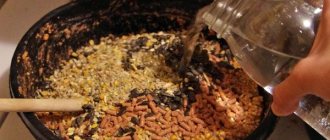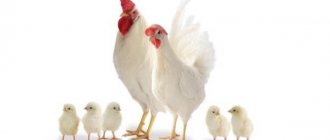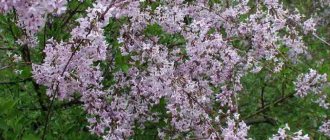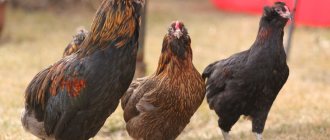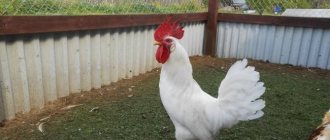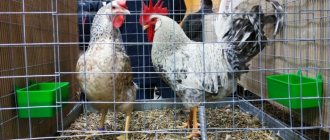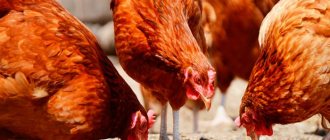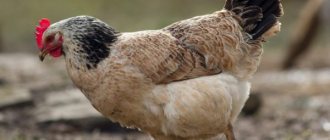External signs
The beak is short, strong, slightly bent. The eyes are amber. The small fan-shaped tail is set high. The wings are shortened. The plumage is lush and dense. Features a variety of colors with contrasting edging.
Wyandotte
The established breed standards are as follows:
- a low comb with a round spike fits tightly to the back of the head;
- eyes red, turning brown;
- massive short beak;
- earlobes and earrings are bright and shiny;
- strong neck with a fluffy collar;
- wide chest, back and shoulders;
- the wings are short, tightly fitting to the body;
- short bushy tail;
- developed braids.
Plumage color options
The description of the breed includes 15 color options. A distinctive feature is the edged plumage. There are silver with various edgings, white, amber, golden, light brown, fawn, red, calico, partridge and blackened varieties.
Wyandotte
Dwarf variety of the breed
It has voluminous, tight-fitting plumage. The chest is wide and deep, the belly is full. The back is rounded. Wide tail feathers. The figure is disproportionate: the body is long, the tail is narrow. The rounded head does not have a spine on the crest. They ripen quickly - they lay eggs at 4-5 months. Dwarf Wyandotte is the most common dwarf chicken breed.
Be sure to read:
The rarest breed of chickens - Ayam Tsemani: breeding, maintenance, egg production
Wyandotte chickens - description
American Wyandottes are medium in size, but boast beautiful lush plumage.
Roosters do not have a very large head with a short yellow beak and a medium-sized comb. The shape of the crest is unusual: it is neither erect nor tilted to the side, as in other breeds, but fits tightly but gracefully to the head. There is also a small round spike on the crest, following the line of the back of the head. The neck is not very long, but strong, slightly bent back, which is why roosters have a very stately appearance. The feather collar on the neck is very fluffy and falls down the back, covering the entire shoulders.
Wyandotte roosters have an unusual figure: due to the fact that the length of the body is noticeably greater than the height, the bird looks squat and wide. And given the lush plumage, the Wyandotte rooster can even resemble a ball on legs. The top line of the body, running from the neck through the back to the tail, is a beautiful curve, shaped like a lyre. The short, bushy tail is well spread, the tail feathers are covered with braids. The back, chest and belly are quite wide and well developed. The legs are long and rich yellow.
Chickens generally have the same characteristics except, of course, for sexual characteristics. Significant differences also include slightly smaller sizes and a more fluffy tail.
The Wyandot breed has at least fifteen color variants (the dwarf subspecies has about 30), among which silver is the most common. In this version of the plumage, a white-gray tint predominates, and black is auxiliary.
In roosters, silver feathers clearly dominate on the head, neck collar, lower back, chest and outer part of the wings. Moreover, each silver feather has a black edge. The tail plumage and flight feathers are rich black, sometimes with a greenish tint. At the same time, the underfeather down is always dark in color. In turn, hens are completely covered with silver feathers, but their black edging is wider, which is why the proportion of black in the total mass is higher than in the case of roosters.
Other color options (with the exception of solid colors, such as white) also have a characteristic edging on the feathers, which is why the edged Wyandotte is always easily recognizable.
Farmers speak mostly positively about the character of these chickens, noting their calm, peaceful disposition and get along with other birds.
Sexual maturity and egg production
Oviposition begins quite late, at the age of six to nine months. During the first year, the hen lays up to 200 eggs, then egg production decreases to 170 eggs per year. The eggs weigh about 60 grams, the shell density is average, the color varies from cream to brown. The productivity of plain hens is several dozen eggs higher than that of representatives with a border.
Chickens gain weight quickly.
Live weight reaches 3.5 and 2.5 kg for roosters and chickens, respectively. The dwarf individual weighs up to 1 kg and lays 120 eggs weighing 35 g per year.
Reviews about the breed
Review from: Nadezhda Viktorovna Polskikh, Vinnitsa region, Ukraine.
Pros: very beautiful, wears well
Cons: none.
We decided to get a purebred bird three years ago - we ordered four silver Wyandottes from Poland - three hens and a rooster, and four Rhode Island reds - two pairs. And although all the birds were adults, there were no problems with maintenance either then or now. One Rhode Island rooster died in an accident. The Wyandots were laying great, now those hens slowed down a little, but a year later one hen sat on the eggs - and gave birth to seven excellent large chickens.
Now we keep a flock of twelve Wyandots - eleven hens and one rooster, which is enough for us. I recommend and praise it to everyone - a beautiful, calm bird, I look at it and relax my soul.
Review from: Ivan Kostyukov, Saratov, Russia.
Pros: gorgeous bird, affectionate, good brood hens.
Cons: It's a shame to cut!
We have a flock of fifteen Wyandots, beautiful different colors - partridges are our favorite. They are frost-resistant and winter in our barn without any problems. The rooster is handsome, but at the same time caring and masterful, and has never attacked anyone.
Chickens older than two years old cluck and hatch chicks every year. We leave the chickens and the cockerels for meat. One thing is bad - it’s a shame to kill a bird. Painfully good! The neighbor says that yours are pheasants. There is no better bird than the Wyandottes!
Dear readers, you have the opportunity to add a review about the breed to the article. To do this, write your detailed comment using the contact form and in the near future it will be transferred to the text of the article. If you are a breeder of purebred chickens and sell young stock or eggs, you can include this information, but do not forget to indicate your region of residence.
Care and maintenance
Chickens of the Wyandotte breed are unpretentious to their living conditions, but are very light-loving, so they need additional lighting during short daylight hours. Due to the large mass of laying hens, it is recommended to install nests and perches at a low height, about 60 cm. There is 1 rooster for every 10 hens.
Representatives of this breed have an active character and need space. The density of keeping chickens in a cage is a maximum of 10 birds per square meter. For walking you will need 0.5 acres, for dwarfs - half as much. The breed's wings are shortened and they cannot fly high, so a fence 1.5 meters high is sufficient for fencing.
Where can I buy? Price
It is better to purchase Wyandottes from specialized nurseries. The following have worked well:
- Moscow region, Mytishchi, st. Border dead end, house 4. “Orlovsky courtyard”.
- Moscow region, Balashikha. "Kingdom of Chickens"
The price of a hatching egg is 40-50 rubles. a piece.
An adult rooster of standard size can be bought for 500 rubles.
An adult chicken – about 400 rubles.
Breeding Wyandottes in Russia is not very profitable due to the high price of breeding birds that are brought from abroad, but if you organize activities in this direction, you can make a good profit, since chicks and hatching eggs can be sold at a high price. In addition, the Wyandots are able to provide the farm with high-quality meat and eggs.
0
0
Copy link
Diet of adult chickens
Protein, protein and easily digestible carbohydrates are added to the feed:
- grain mixtures (best before bedtime);
- vegetable mixtures;
- fish and meat waste;
- bone flour;
- sand and small stones;
- source of calcium: chalk and crushed shells;
- feed;
- fresh greens in summer and chopped hay in winter.
Chickens eat a lot and quickly gain weight, but can become obese. Then you need to limit the amount of carbohydrates.
Oviposition begins quite late, between six months and nine months of age.
Nutrition of chickens and young animals
In the first three days, chickens are fed boiled egg whites and semolina six times a day. Then cottage cheese, greens and meat are gradually introduced, the number of meals is increased to three. At one month of age, the chicken is transferred to an adult diet.
Be sure to read:
Legbar chickens: description, characteristics of a bird that lays blue eggs
Egg production and weight
An adult Wyandotte chicken can produce up to 140 eggs per year. But according to farmers, the annual number of eggs laid can reach 200 eggs. It all depends on the care and nutrition of the birds.
Depending on the age of the hen, the weight of eggs ranges from 48 to 62 grams, but most often it is 53 grams.
Many poultry farmers note that birds with solid or black feathers are more likely to lay eggs. Blue-edged Wyandotte produces fewer eggs. Therefore, it is more often bought as an ornamental pet to decorate the poultry yard.
The description of the Wyandotte chicken breed says that roosters grow from 3 to 3.8 kilograms, chickens - from 2.4 to 3 kilograms.
Breeding and raising chickens
Representatives of the breed are constantly crossed to produce highly productive individuals with purebred color.
Chickens are healthy and do not require special care. The survival rate is almost one hundred percent. The greatest vulnerability is in the first week and a half. Conditions for this period:
- temperature regime 30-32 degrees;
- clean litter;
- lack of humidity.
After two weeks, the temperature drops to 26 degrees; in sunny weather, the chickens are released outside.
Wyandotte
Characteristic
Wyandottes have an extremely bizarre appearance and can be confused with other breeds. However, becoming familiar with the standards set by veterinarians will help you select healthy purebreds to successfully breed high-producing birds. If you are a beginning farmer, carefully consider all the advantages and disadvantages, analyze possible difficulties, so that the features of care do not become an unpleasant surprise (as well as unexpected changes in productivity).
Appearance and standards
Wyandotte chickens have a specific appearance that makes them stand out from other laying hens. Distinctive features are:
- variegated color of large feathers that fit tightly to the body. In the classic version, the middle part of the feather is white and bordered by a silver-black stripe. There are also golden-red and pure black specimens;
- the body is rounded, the keel is poorly defined, the skeleton and muscles are well developed;
- The tail feathers of hens are white, those of roosters are motley (depending on the main color of the plumage), the braids do not appear;
- small black eyes surrounded by red bumpy skin;
- the body is disproportionate: small head, long neck, straight elongated body and long legs;
- the legs are powerful, strong, covered with dense pale yellow skin;
- the comb is small, the teeth do not stand out, the earrings are voluminous and bright red.
When purchasing chicks that differ in appearance from adults, carefully examine their muscles. Young animals at an early age have a strong build, well-developed legs and wings. The color of the chickens is uneven, although there are no variegated main feathers yet.
If the bird does not fully correspond to the description, then it is not suitable for breeding. However, they should not be completely discarded; they are suitable for egg production.
Character
The Wyandotte breed is distinguished by its pliable, friendly character, which can be considered a significant advantage for a bird. Several roosters can coexist in the same territory without fighting or displaying aggression. Also, thanks to its calm disposition, it can be kept together with representatives of other species. Find out why you need a rooster in a chicken coop here.
The only disadvantage of the breed is their lazy behavior.
Wyandots are often at risk of obesity due to their sedentary, measured lifestyle. To avoid this problem, organize a walking space and a system of perches of different heights.
Origin
American breeders have been working on this breed for several decades. The final copy was received in 1883. Several of the most productive breeds common in North America were taken as a basis: Leghorn, Cochiquin, Dorking, Orpington and Bentham Seabright. The birds arrived in Europe a year later, but in Russia they became known only in 1911. Despite the success in breeding Wyandots (this name is of Indian origin), work on the breed continued for many more years. Today, about 15 subspecies are known, differing in plumage color, body size, and productivity. Also read about Brahma chickens at this link.
When purchasing, check which subspecies the bird belongs to. For example, the presence of brown spots in the plumage is unacceptable for silver wyandots. And for golden ones, gray inclusions are considered a defect.
Advantages and disadvantages
The breed has few disadvantages. The main one is the tendency to obesity, which worsens the taste of meat. Also, with improper weight gain (and the reason may be improper feeding, non-compliance with living conditions, or a sedentary lifestyle), egg production is reduced by approximately 50%.
These crosses have many advantages:
- ability to adapt to new conditions;
- delicious meat, tender and soft;
- fertility, large broods both during natural hatching and in the incubator;
- good health in all weather conditions;
- good egg production rates.
Unstable genes can also be considered a small disadvantage. When accidentally or intentionally crossed with other species, the characteristics of Wyandottes are suppressed.
Common diseases and their prevention
Wyandottes rarely get sick; most often they suffer from parasites, so the chicken coop is regularly disinfected. There are no typical diseases; standard vaccination is sufficient.
These are clean chickens; the roosting area needs constant cleaning. Wyandottes are afraid of drafts and dampness; you need to take care of warm bedding. The immune system is susceptible to infections of other birds, so contact with them is undesirable. To strengthen the immune system, it is recommended to arrange ultraviolet baths.
Metatarsus and feathers will tell you about the disease. Ruffled plumage and pale legs indicate the need for isolation of the bird.
Wyandotte chickens
Possible diseases
The birds are in good health. The most common diseases include:
- Parasitic infestations most commonly affect Wyandots. Therefore, it is necessary to avoid contact with other animals and birds and regularly disinfect the house and nests.
- Arthritis – can develop due to dampness in the chicken coop. To prevent this, you should monitor the litter, change it promptly, especially if it is damp, and provide good ventilation.
- Infectious diseases most often affect young individuals. Preventive measures should be followed and vaccinations should be carried out in a timely manner.
Read about other chicken diseases here. Chicks are most vulnerable to various diseases up to 10 days old, after which their health improves.
Advantages and disadvantages of the breed
They have the following advantages:
- good frost resistance;
- high productivity, including in winter;
- chick survival;
- friendly character;
- taste qualities of meat and eggs.
There are also disadvantages:
- vulnerability to obesity;
- rare, bred only in private farms;
- cost as a consequence of low prevalence.
Wyandotte chickens
Advantages and disadvantages
Birds of this breed have their pros and cons, which breeders should be aware of before purchasing them.
The main advantages of Wyandottes:
- high resistance to frost;
- Laying hens produce a large number of eggs per year, without reducing egg production even in the cold season;
- hatchability of chickens - about 98%, extremely high viability of offspring;
- individuals have a calm and friendly disposition, they get along easily with other inhabitants of the poultry house, and do not require placement in another room;
- meat and egg products have excellent taste.
Negative aspects of the breed:
- these birds lead an inactive lifestyle and are sedentary;
- due to low physical activity, they are prone to obesity;
- The breed is quite rare, so its cost is higher than other species.
Prospects for breeding the Wyandotte breed in Russia
Wyandotte chickens are suitable for harsh winter climates. The ability to withstand frost and low mortality of offspring allows you to quickly recoup costs. The chickens grow without the active control of the owner and are in demand.
It is worth breeding Wyandottes as an ornamental show breed due to the variety of colors. This is complicated by the low representation of the breed in Russia, because selection requires representatives of different lines.
Farmers who have purchased purebred Wyandots leave extremely positive reviews.
It is quite difficult to acquire a purebred representative, but if the opportunity arises, you need to spend money.
Origin story
Wyandotte chickens are a breed that was developed in the second half of the 19th century in America. It received its name in honor of the tribe that lived in the territory of the modern United States - the Hurons. They called themselves Wyandots.
To create the breed, experts crossed 6 different types of chickens:
- Brahma;
- Seabright;
- Orpington;
- Leghorn;
- Dorking;
- Cochin.
The Wyandotte breed received the best qualities from them.
There is a silver and dwarf type. The first variety is considered the standard.
In Russia, they became acquainted with this type of poultry back in 1911. However, it has not become particularly popular here, although it tolerates low air temperatures well.
Gender and other differences
To save time and effort, you can purchase already grown chicks. But there are several nuances here.
You can determine that there are Wyandotte representatives in front of you after the juvenile (first) molt, which usually begins at the 4th week of their life and lasts 1.5-2 months. The feathers of chickens have completely different shades.
Young representatives of the breed are separated by gender only a few months after birth.
Wyandotte roosters begin to crow very early. The first sounds are observed within a month.
Breeding young animals
Wyandotte breeding has its own nuances. Inbreeding negatively affects the quality of products and the survival rate of young animals. In this regard, it is necessary to maintain the maternal and paternal lines separately. Due to hybridization, it is difficult to calculate color transmission genetically. It is better to hatch chickens naturally, since it is difficult to obtain high-quality material for incubation.
Putting a chicken on eggs
The hen is selected based on behavioral reactions indicating her readiness to hatch:
- The black clump croaks for a long time;
- spends most of the time in the nest;
- plucks out its down and feathers, placing them in the nest.
Having chosen a hen, start organizing the nest.
Place it in a secluded place. The optimal size of the nest is 55x35 cm. Place soft hay in it, and the chicken will finish the rest itself. Important! If there are 2 or more hens in the same area, they need to be seated further away from each other, otherwise they will begin to conflict, which will lead to poor-quality incubation and reduce hatchability.
For incubation, medium-sized eggs are taken. Before storing, biomaterial cannot be stored for longer than 3 days. Wyandottes are placed in a nest of 13–15 pieces. eggs Check all biomaterial for damage. Examine under an ovoscope. Discard eggs that contain an air chamber in the blunt side of the egg. Material that contains a bloody clot or inclusions of unknown origin is not suitable.
The eggs are laid when the hen is outside the nest, for example, when she goes out to eat. During the hatching process, biomaterial is no longer reported, because after the chicks hatch, the hen will leave the nest. The hens are kept at a temperature of +15…+20 °C and a relative air humidity of 70–75%. Make sure that the chicken eats fully and leaves the nest for no more than 20 minutes.
The chicken's diet includes mixed feed, carbohydrate foods, represented by root vegetables and grass. If the hen has not returned to the nest after 20 minutes, bring her back yourself. While the chicken is eating, inspect the nest, clean it of dirt, and remove crushed eggs. The incubation process takes 19–22 days. Chicks do not appear at the same time. As the chicks hatch, they are taken away and allowed to see their mother only after vaccination.
Vaccination of young animals
Unvaccinated chickens can become carriers of infection. The vaccination schedule looks like this:
- Immunization of parental animals against mycoplasmosis 100–120 days before brooding.
- The first 24 hours - infectious bronchitis, Marek's disease.
- 7 days - Newcastle disease.
Important! If the epidemiological situation in the growing region is unstable, additional vaccines are introduced and the schedule for disinfection of the poultry house is increased.
The Wyandotte chicken breed is one of the most productive. Refers to the meat and egg direction. It has high growth rates and good productivity. The breed is popular in Europe; in our country it is not used for industrial purposes; it is bred by amateur farmers.
Care and feeding of chickens
Chicks are vulnerable during the first 10 days of life. All this time they are kept in a box on a soft, warm fabric bedding, which is changed as needed. The optimal temperature from the 1st to the 5th day of life is 30 °C, then it is gradually reduced to 20 °C.
For the first 2–3 weeks, the young animals are fed boiled eggs and cottage cheese. Millet is gradually introduced, and then feed. After a month, they are transferred to age-appropriate premixes.
Reviews from Wyandotte owners
Igor Anashkin, Vorontsovka village
I once saw these chickens in a photograph and caught fire. I have been looking for access to breeding breeding centers for a long time. Finally we managed to get eggs of the classic “silver-edged Wyandotte” variety. The bird is truly amazing. Its disadvantage is its reluctance to move a lot, like other chickens. Because of this, it is necessary to strictly monitor the diet of the Wyandots so that they do not become obese. On the other hand, due to their sedentary lifestyle, less feed is consumed than other chickens. You also need to monitor the food and add more animal proteins and calcium. Otherwise, there is no hassle with this breed.
Sergey Gumenyuk, Oktyabrsky village
The bird is simply wonderful. Our winters are cold, but the Wyandots don’t care. Of course, you can’t keep them completely in the snow, but in a cold chicken coop they overwinter just fine. Of course, egg production in this case decreases. If you want eggs, raise the temperature to at least 10 degrees. Another bad thing for me is that the Wyandottes turned out to be of different colors. I won’t be able to do pure breeding, the livestock is too small, and if mixed from parents of different colors, anything can come out.
Character of birds
Representatives of the Wyandotte breed are distinguished by their calm and balanced character. Hens and roosters are peaceful. They get along well not only with their brothers, but also with other birds.
An interesting fact is that Wyandotte chickens can be housed together with pigeons and quails.
Wyandots are not shy - they are not afraid of people and after just a few days of being kept in the house they begin to respond to the call of their owner. In general, birds easily contact new people and do not show aggression, even when near their chicks.
The unique thing about Wyandotte chickens is that they are trainable. If you are often with them and communicate, then in the near future they will begin to follow basic commands, which children especially like. Birds will become their favorite pets.
